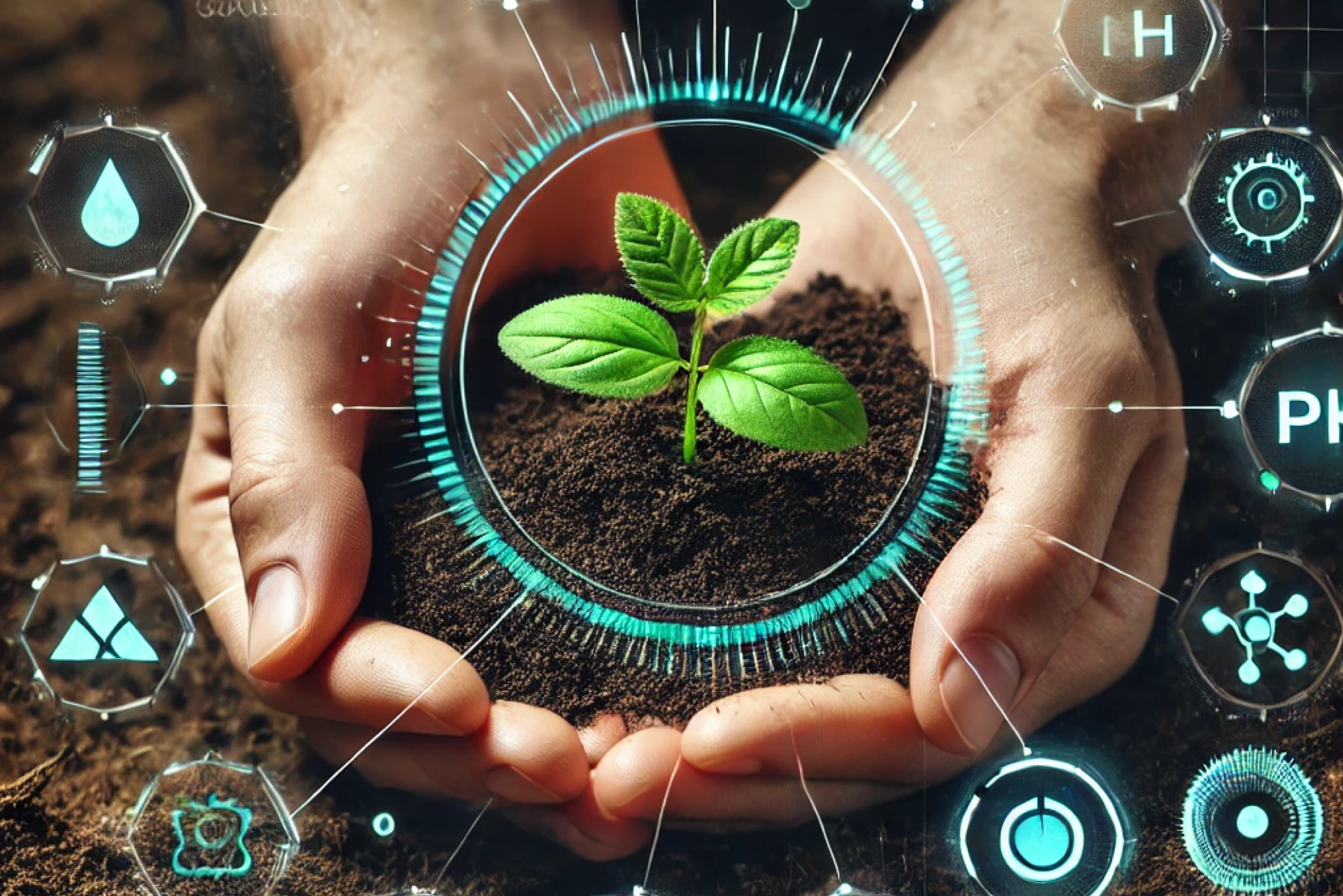Introduction:
Soil fertility is the foundation of successful farming. Soil samples provide farmers with valuable insights into nutrient availability and soil composition, helping to optimize yields and use resources efficiently. However, in addition to fertility optimization, legal requirements and innovative technologies are also becoming increasingly important. This article shows how soil sampling is transforming agriculture sustainably.
What are the benefits of soil sampling?
- - Nutrient Analysis: They provide precise data on nitrogen, phosphorus, potassium, and trace elements, forming the basis for targeted fertilization.
- - pH Value Determination: The pH value affects nutrient availability. Soil samples help determine lime requirements and optimize soil reaction.
- - Compensatory Fertilization: Soil samples enable the replenishment of nutrients removed during harvest, securing long-term fertility.
- - Sustainability: Targeted fertilization recommendations avoid over-fertilization, protecting the environment and water bodies.
- - Yield Improvement: Optimal nutrient supply promotes plant growth and increases productivity.
What are the legal requirements?
- - EU Fertilizer Regulation (DüngeVO): This regulation requires all farmers in Germany to regularly perform soil sampling to monitor nutrient balance and comply with legal fertilization planning requirements. Particularly strict rules apply in nitrate-sensitive areas to protect groundwater and the environment. Details are outlined in the 2020 Fertilizer Regulation, which mandates comprehensive documentation and regular updates of soil analyses. Non-compliance can lead to legal consequences.
- - Documentation Obligations: Farmers must document the results of soil analyses and the fertilization recommendations based on them to ensure compliance with legal requirements and nutrient balance. Violations can result in severe penalties, including fines or restrictions on land use.
- - Nutrient Limits: Strict nitrogen and phosphorus limits apply in many regions, especially in nitrate-sensitive areas. Soil samples are essential to verify compliance with these limits and prevent over-fertilization, which could lead to groundwater contamination. These requirements are detailed in the EU Fertilizer Regulation.
What measurement methods exist, and what are their pros and cons?
Classical Laboratory Methods:
- Potassium Chloride Extraction (KCl): Primarily used for determining the available nitrogen (Nmin), essential for plant growth. Advantage: High accuracy in nitrogen analysis. Disadvantage: Time-consuming due to multiple steps and chemical reagents. Provides no information on other nutrients like phosphorus or potassium.
- CAL Method: Measures plant-available phosphorus and potassium, critical for plant growth. Not used for nitrogen analysis. Advantage: Well-established and provides comparable results. Disadvantage: Lacks information on organically bound nutrients, limiting its utility in specific cases.
- Ammonium Lactate Method (AL): Used for determining micronutrients like zinc, iron, or copper. Not used for nitrogen analysis. Advantage: Covers a wide range of parameters. Disadvantage: Time-intensive and requires trained personnel due to the use of chemical reagents.
In-situ Methods:
- Rapid Tests: Field tests typically checking nutrients like nitrogen (to a limited extent), phosphorus, and potassium, as well as pH values. Advantage: Immediate results and cost-effective. Disadvantage: Often less accurate than laboratory methods, and result comparability depends heavily on the equipment used. Accuracy usually ranges between 80% and 90% compared to classical lab analyses, depending on soil conditions and tested parameters.
Spectroscopy (e.g., NIR):
- Near-Infrared Spectroscopy: Measures organic compounds and physical properties. Used both in labs and on-site. Typically checks nutrients like organic carbon, nitrogen, and micronutrients. Advantage: Fast, environmentally friendly, and requires no chemical reagents. Disadvantage: High equipment costs, and accuracy can vary with complex soil samples. Accuracy is generally 85-95% compared to classical laboratory methods.
The German Agricultural Society (DLG) has tested various measurement methods and provides specific recommendations. For detailed laboratory analyses, potassium chloride extraction (KCl) remains a reliable method for nitrogen analysis, while the CAL method continues to be the standard for phosphorus and potassium. Rapid tests and spectroscopy, such as the "AgroCares Scanner" or the "Veris MSP3 System," are considered practical but show variations in accuracy depending on soil conditions and application areas. Overall, the DLG recommends choosing the measurement method based on the specific application and relying on laboratory analyses for complex issues.
What is currently happening in technology/innovation?
Soil sample analytics are rapidly evolving to provide farmers with faster, more precise, and cost-efficient tools. Especially in digital and automated solutions, there are exciting advancements that could significantly change practices.
- Mobile Sensors: Portable sensors enable farmers to measure soil parameters directly on-site without needing to send samples to a lab. These sensors use technologies like near-infrared spectroscopy or electrochemical sensors to measure values like pH, moisture, and organic carbon. According to the German Agricultural Society (DLG), systems like the "AgroCares Scanner" and the "Veris MSP3 System" have been tested. The "AgroCares Scanner" showed good basic accuracy for pH measurement but variations in nutrient analyses like phosphorus and potassium. The "Veris MSP3 System," on the other hand, provided precise results for soil conductivity and organic matter measurement but is recommended for specific applications. Overall, the DLG emphasized that the systems are practical but may have limitations depending on the application area. Accuracy varies by device and soil type, often ranging between 85 and 95%. Costs for such devices range from €2,000 to €10,000, depending on the technology and parameters measured.
- Biological Indicators: New research focuses on evaluating soil biology, such as microbial diversity, to assess soil quality more comprehensively. Standardized test methods are applied to examine soil samples for the diversity and activity of microorganisms. Providers like "Solvita" or "Biolog Inc." offer such analyses, with CO2 release being a common indicator of microbiological activity. Costs for these tests vary widely, often between €50 and €150 per sample, depending on the provider and scope of analysis. The German Agricultural Society (DLG) has partially tested such methods and highlights their potential but also points out the need for further development to increase reliability for different soil types. Overall, these methods are seen as having innovative potential for sustainable agriculture.
Conclusion:
Soil samples are indispensable for sustainable and successful agriculture. They form the basis for precise decisions and help meet legal requirements while promoting environmental protection. Thanks to innovative technologies such as mobile sensors and biological indicators, soil diagnostics are continuously evolving and becoming more accessible and practice-oriented. The German Agricultural Society (DLG) emphasizes that farmers should tailor their choice of measurement methods to their specific needs. This ensures the connection between technological progress and sustainable agriculture remains future-proof. How do you utilize these opportunities? Share your experiences and ideas in the comments!
Do you have suggestions or questions about this article or topics related to agriculture, digitalization, AI, and AgTech? Feel free to send us an email at support@tunen.ai or message us on Instagram or LinkedIn. We look forward to hearing from you.

